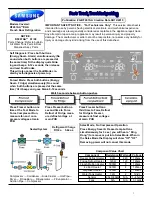
54
TK 56433-5-MM-EN
Figure 59.
Final Fan Drive Belt Alignment
10. Check the belt tension with Frequency Gauge P/N
2041903. The recommended setting for a new belt
is 106-118 Hz. If the tension is in this range, the
mark on the tensioner arm should align close to the
lower mark on the tensioner housing as shown
below. If the belt tension frequency is not in the
recommended range, the sliding idler pulley
position can be adjusted to increase/decrease belt
tension. See “Fan Drive Belt Adjustment” below.
N
No
otte
e:: The belt tension frequency measurement should
be the primary method used to determine the
correct belt tension. The markings on the
tensioner arm and housing exist to provide a
rough visual reference of the belt tension.
Figure 60.
Tensioner Mark Alignment
11. Monitor belt tension regularly during the run in
period (initial 10 hours). After the belt has run in,
the mark on the tensioner arm should rest between
the two marks on the tensioner housing.
Fan Drive Belt Adjustment
The sliding idler pulley position is set during factory
production for the correct belt tension. If required, its
position can be adjusted in the field to achieve the
required tension as follows.
N
No
otte
e:: The distance given below is the nominal starting
point and the exact location will depend on the
variation of the drive system layout.
1. Measure from the center of the sliding idler pulley
bolt to the center of the end of the slot in the frame
as shown below. The factory setting is 2.81 in. (71.5
mm).
Figure 61.
Sliding Idler Pulley Position
2. Perform steps 1-3 of “Fan Drive Belt Replacement”
above to loosen the belt tension.
3. Loosen the sliding idler pulley bolt and adjust
sliding idler position as required.
4. Tighten the sliding idler pulley bolt.
5. Perform steps 7-10 of “Fan Drive Belt Replacement”
above (reset belt position and measure belt
frequency to ensure correct belt tension).
















































